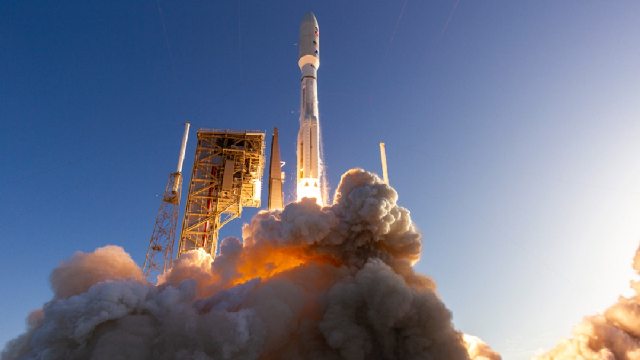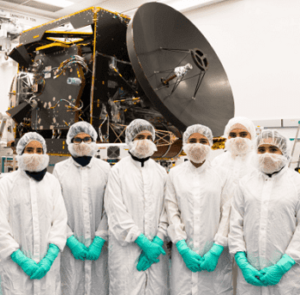Three missions, three countries, one destination.
Inspire year 5 students in STEM by showing them the huge achievements being carried out, around the world, right now by people who have an understanding of Earth and Space Science as they journey to Mars.
Word Count: 817

Mars is about to become crowded. When the spacecraft carrying NASA’s Perseverance rover safely launched from Cape Canaveral on 30 July, it became the third in a small fleet of spacecraft now heading for the Red Planet: one from the US, one from China, and one from the United Arab Emirates.
Any Mars launch is exciting, but with three space agencies all planning to arrive at Mars next February, the drama is more intense than usual. Not to mention that NASA’s launch was accompanied by a small earthquake, magnitude 3.9, which rattled its Jet Propulsion Laboratory in Pasadena, California – one of the sites overseeing the launch – about 20 minutes before liftoff.
Happily, the earthquake did not affect the mission, which lifted off exactly on schedule at 7:50 Eastern Daylight Time. “They never lost the signal,” says launch manager Omar Baez. “They said they were ready to proceed, and we able to launch on time.”
“It was just the Earth being excited about going to Mars,” jokes JPL’s director, Michael Watkins.
The first of the three missions, called Hope (Al Amal in Arabic), was launched by the UAE Space Agency – a newcomer to planetary exploration – atop a Japanese rocket on 20 July.
The mission is the first Mars launch ever attempted by an Arab nation. The name was chosen because “it sends a message of optimism to millions of young Arabs”, says Sheikh Mohammed bin Rashid Al Maktoum, ruler of the Emirate of Dubai. “If a small, young Arab nation is able to reach Mars, truly anything is possible,” adds project manager Omran Sharaf.

It’s a message of hope also to women scientists who, according to a tabulation by the New York Times, make up a whopping four-fifths of the entire science team.
“The government has invested heavily in education, especially women’s education, says Robert Lillis, associate director for planetary science at the University of California Berkeley’s Space Sciences Laboratory, which provided science collaboration, training, and instrument components for the mission.
The project, he says, is part of the Emirates effort to prepare for a post-oil world, “to lay the groundwork for a future in which entrepreneurs, inventors and ideas – not oil – are funding their economy”.
The mission is an orbiter designed to study the Martian atmosphere and weather in unprecedented detail.
“Our science mission is to produce the first-ever truly global picture of the Martian atmosphere,” says Sharaf. “This is the first holistic study of the Martian climate and how the layers of the atmosphere fit together.”
The Chinese launch, a mission called Tianwen-1, came three days later. (Its name means “heavenly questions”, chosen in honor of a 2300-year-old classical Chinese poem.)

2020.
It is China’s second attempt to go to Mars. The first failed in 2011 when the Russian mission on which it piggybacked couldn’t get out of Earth orbit.
Since then, China has had two successful landings on the Moon, and with Tianwen-1 is attempting a twofer: a package that includes both an orbiter and a rover.
If the rover lands safely, China will become only the third country to successfully land on Mars. (The other two are the US and the former Soviet Union, whose Mars 3 lander survived a mere 110 seconds after it soft-landed in 1971). It will be only the second to deploy a rover.
Although it will reach Mars in February, it won’t land immediately. Instead, it will go into a mapping orbit, trying to pick the best landing site before the rover attempts the descent a couple of months later.
NASA’s Perseverance mission is a prelude to a hoped-for Mars sample return mission scheduled for 2026-2031. Its job is to explore a crater that was known to host a lake, collecting rock samples that might contain signatures of ancient life. It will then cache these samples for later retrieval and return to Earth for examination with much more advanced laboratory equipment than can be put on a rover.
In the process, Perseverance will also study the crater’s geology, attempt to make oxygen from the carbon dioxide in the thin Martian air, and even deploy a helicopter that, if all goes well, will make the first powered, controlled flight on an alien world.
A fourth probe, also a rover, also was scheduled for launch this month, this one a joint project of the European Space Agency and Russia. It has been postponed to 2022, however, due to an engineering problem.
A two-year delay was required because Mars launch windows only occur every 26 months – the reason why four different programs had all scheduled launches for this month.)
Meanwhile, Hope, Tianwen-1, and Perseverance are securely on their way.
“I’m looking forward to ideally a very quiet and boring trip to Mars, as we prepare for the never-boring and always-stressful entry, descent and landing,” says Perseverance’s chief engineer, Adam Steltzner, in a sentiment that is undoubtedly shared by the Chinese and the Emiratis.
This article is originally published by Cosmos as Mars is the place (in space) to be.
Login or Sign up for FREE to download a copy of the full teacher resource





